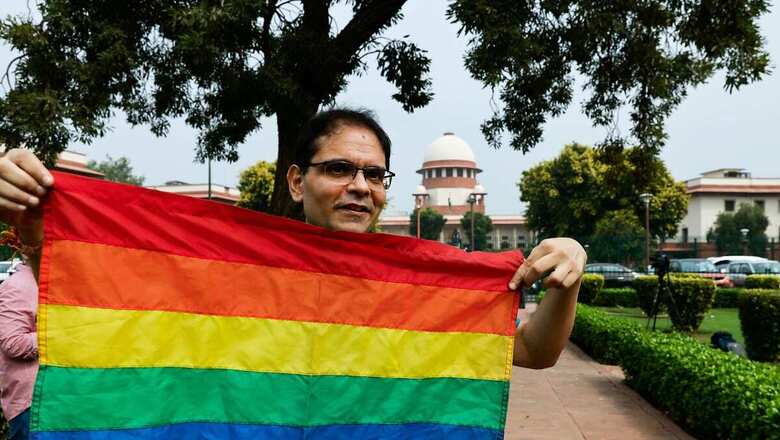
views
The Supreme Court on Tuesday refused to grant legal recognition to same-sex marriages. A Constitution Bench led by Chief Justice of India DY Chandrachud pronounced its verdict on 21 pleas seeking legal validation for same-sex marriages and said the court can’t make law but only interpret it and it is for Parliament to change the Special Marriage Act.
The case was seen as a milestone event for LGBTQ rights in India, following a historic 2018 judgement by the Supreme Court that scrapped a colonial-era ban on gay sex. Only Taiwan and Nepal allow same-sex unions in Asia, where largely conservative values still dominate politics and society.
The five-judge bench heard arguments in the case between April and May and reserved its order on May 11. The other members of the bench are Justices Sanjay Kishan Kaul, S Ravindra Bhat, Hima Kohli and PS Narasimha.
TIMELINE
Here’s a look at how the issue and the case have evolved so far:
Pre-Independence India
During British rule in 1860, homosexual intercourse was considered unnatural and was declared a criminal offence under Chapter 16, Section 377 of the Indian Penal Code. Section 377 was introduced by the British, modelled on the Buggery Act of 1533. This section of the Buggery Act was drafted by Thomas Macaulay in 1838 and was brought into effect in 1860. It defined ‘buggery’ as an unnatural sexual act against the will of God and man, thus, criminalising anal penetration, bestiality and homosexuality, in a broader sense.
Section 377 dealt with “unnatural offences” and held “whoever voluntarily has carnal intercourse against the order of nature with any man, woman or animal shall be punished with imprisonment for life, or with imprisonment of either description for a term which may extend to ten years, and shall also be liable to fine.” The law allowed the judiciary to “punish” LGBT individuals with up to 10 years in jail as well as a fine.
Independent India
On November 26, 1949, the right to equality was enshrined under Article 14, but homosexuality remained a criminal offence. In the decades that followed, members of the LGBT community faced persecution and ostracism in many forms.
Decades later, on August 11, 1992,, the first known protest for gay rights in India was held. In 1999, Kolkata hosted India’s first Gay Pride Parade. The parade, with only 15 attendees, was named Calcutta Rainbow Pride.
Pride Movement In India
In 2009, the Delhi High Court, in Naz Foundation vs Govt of NCT of Delhi, ruled that Section 377, which criminalised same-sex relationships, was unconstitutional, and struck the law down, decriminalising homosexuality in India for the first time. It stated that treating consensual homosexual sex between adults as a crime is a violation of fundamental rights protected by India’s Constitution.
The verdict, which was hailed as a victory for LGBT rights, was challenged by several anti-gay rights groups on religious, political, and social grounds, who claimed that the right to privacy did not include the right to commit an offence and that decriminalising homosexuality would affect the institution of marriage.
In 2013, in the Suresh Kumar Koushal and Another v. NAZ Foundation and Others case, the Supreme Court overturned the Delhi High Court ruling and reinstated Section 377 of the Indian Penal Code. The SC reversed the Delhi HC’s decision to decriminalise homosexuality, stating that “it was up to the Centre to legislate on the issue”.
In 2015, Congress MP Shashi Tharoor introduced a bill to decriminalise homosexuality, but it was rejected by the Lok Sabha.
In 2017, the Supreme Court upheld right to privacy as a fundamental right under the Constitution in the landmark Puttuswamy judgment. This gave renewed hope to LGBT activists.
On September 6, 2018, the Supreme Court ruled unanimously that Section 377 was unconstitutional “in so far as it criminalises consensual sexual conduct between adults of the same sex”. A five-judge SC bench, which included then CJI Dipak Misra, passed a historic order. The verdict came on a petition by choreographer Navtej Singh Johar and 11 others challenging the constitutional validity of Section 377.
In his verdict, then CJI Misra wrote: “Social exclusion, identity seclusion and isolation from the social mainstream are still the stark realities faced by individuals today and it is only when each and every individual is liberated from the shackles of such bondage and is able to work towards the full development of his/her personality that we can call ourselves a truly free society.”
In April-May 2023, a five-judge bench of the Supreme Court headed by the Chief Justice of India heard arguments in the case between April and May and reserved its order on May 11.
On October 17, 2023, the bench refused to grant legal recognition to same-sex marriages, saying it’s for Parliament to change the Special Marriage Act.
CENTRE’s POSITION
During the arguments, the Centre had told the apex court that any constitutional declaration made by it on the petitions seeking legal validation for same-sex marriage may not be a “correct course of action” as the court will not be able to foresee, envisage, comprehend and deal with its fallout.
The Centre had also told the court it had received responses from seven states on the issue of same-sex marriage and the governments of Rajasthan, Andhra Pradesh and Assam had opposed the petitioners’ contention seeking legal endorsement for such wedlock.
The apex court had commenced hearing arguments in the matter on April 18. While hearing the matter on May 11, the bench had observed it cannot give a declaration on same-sex unions on the anticipation as to how Parliament is likely to respond to it.
The bench made the observation after one of the advocates appearing for the petitioners referred to judicial verdicts, including in the instant triple talaq case, and said once the top court gave a declaration to pass a law penalising the practice, it was a matter for “fairly easy legislative consensus”.




















Comments
0 comment